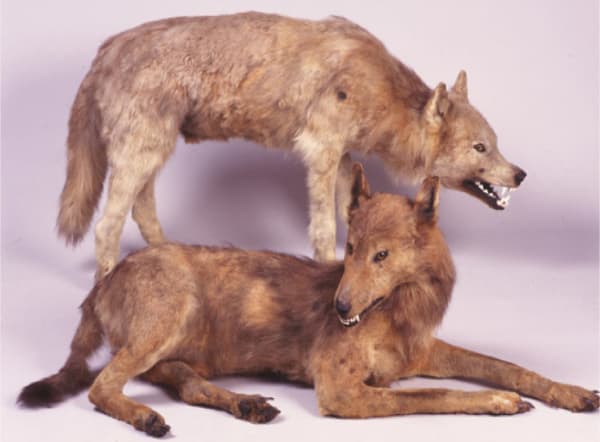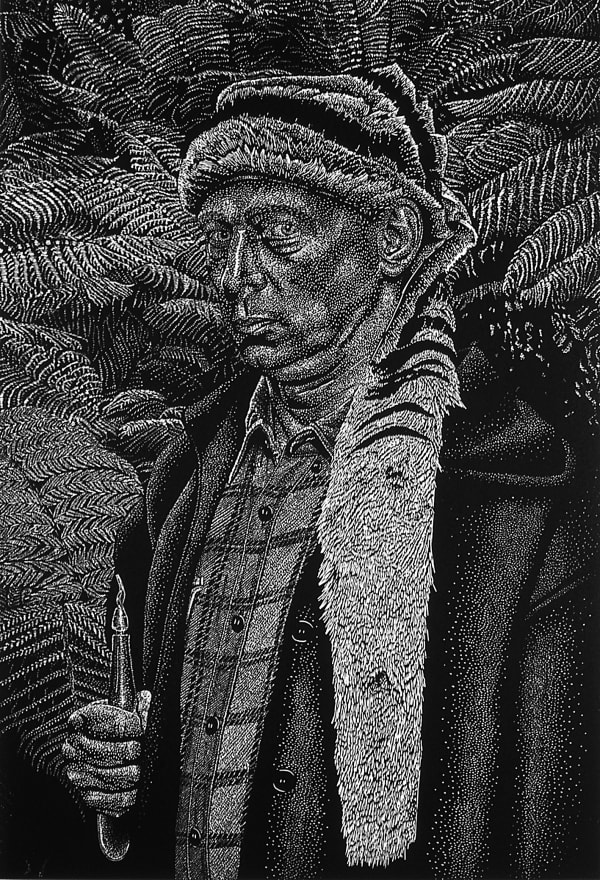It is 1950 on the island of Hokkaido, Japan. G-san, who lives in a charcoal burner’s hut in the Hatenashi Mountains, hears an animal crying nearby. Startled and frightened, he stokes up the fire. At another time he thinks he hears wolf howls where the forest is dense, sees the leaves shaking and then hears a low growl from the unseen creature.
There have been many reports of sightings, paw prints and fur as well as sounds of the Ezo wolf since the species was exterminated in 1889. They reached a peak in 1945-50, but later reports are considered to lack credibility.
This species is not the only one that has also been the subject of extensive searches and analysis of evidence. There is Semplar’s warbler on the island of St Lucia, the golden toad in Costa Rica, the ivory-billed woodpecker in Louisiana, the Yangtze River dolphin and big cats in Britain.
There are poignant similarities between the history of the Ezo wolf and Tasmania’s thylacine – a species officially extinct, but still the subject of numerous reported sightings in several states in Australia, as outlined in Crispin Andrews’ article in Forty South magazine (Tiger time, p59, Issue 82). The Ezo wolf was seen as a threat to livestock when American-style cattle ranches were established in Japan in the late 19th century. Strychnine-laced bait and a state-imposed bounty system was used to eradicate the species, just as the thylacine was accused of sheep-killing and government-sponsored bounties were applied.

Like the Ezo wolf, the thylacine was a keystone predator that largely kept out of sight of humans and, like Hokkaido, Tasmania has a large area of rugged wilderness. These factors encourage the idea of possible survival. They are out there, believers say – not gone, just hiding.
On this basis, many searches have been conducted for the thylacine, despite the final bounty figures: within a few years of the start of the 10th century, only two or three a year were bring brought in; by 1909 it was zero.
The first search was made as early as 1937, a year after the species had been given protection. Its results were declared “rather negative” by the Tasmanian Animals and Birds Protection Board. Apart from Fleay’s search in 1945-46, searches in 1938, 1959, 1960, 1961, 1963, 1967-73, 1980-81 and 1982-83 also failed to return with any irrefutable evidence that the species had survived.
The most extensive searches were conducted by Jeremy Griffiths and James Malley, later joined by former Greens senator Bob Brown, in what they hoped was an attempt to save the tiger from extinction. Jeremy Griffiths was 21 when he began his search. He wrote later that during this period of his life he formed the belief that people lived with “a compromised frame of reference. They seemed to not see the world honestly or truthfully.”
In 1973, after a total of six years of expeditions, Griffiths, Malley and Brown became completely disillusioned about the possibility of the thylacine’s survival.
Many more groups, including scientists and parks and wildlife personnel experienced in tracking animals, and with good knowledge of the areas searched, were unable to substantiate sightings. Others published their conclusions. Tasmanian zoologist Eric Guiler, who conducted his own search in 1963, titled his books The Tragedy of the Thylacine and A Lesson to Be Learnt (although privately he expressed a belief that some may have survived). In his detailed report on the thylacine for Tasmanian Parks and Wildlife Service in 1980, Stephen Smith concluded that the possibility of survival was “remote”. Historian Robert Paddle’s book The Last Tasmanian Tiger, based on exhaustive archival research of the events surrounding the disappearance of the thylacine, leaves no doubt that the species is extinct. Recently, with more sophisticated methods of analysing evidence, study after study have come to the same conclusion.
And rewards were offered. In 1984 US media magnate and philanthropist Ted Turner offered $100,000 for proof of the species’ existence. Then, on its 125th birthday, the now-defunct Australian weekly magazine The Bulletin offered a $1.25 million reward for “conclusive proof of the tiger’s existence”. The Bulletin received lots of foggy (“dodgy” they called them) photographs, similar to the video displayed by the Mercury on Threatened Species Day in 2016. Stephen Sleightholme is quoted in Crispin Andrews article as saying, “However wellmeaning, grainy footage or out of focus photographs do not constitute proof.”

Self portrait of Hanks with lino cutting tool that acknowledges the power of artists to refigure the thylacine and redress nineteenth century extinction practices.
Greens politician Nick McKim called The Bulletin’s offer a “bounty”. But the living, breathing animal that the magazine was looking for was never produced, so the thylacine and the money were safe.
If you are still not convinced the thylacine is gone, consider this: when Europeans settled Tasmania, it is generally agreed there were 2,000 to 4,000 thylacines present in all but the far south-west and in addition to earlier private bounties, there were 2,089 government payments recorded between 1888 and 1909.
Scientists find it difficult to estimate the smallest population size at which a species can exist given natural disasters, habitat changes or events such as outbreak of disease. The smaller the population, the more likelihood that species viability will be adversely effected by inbreeding and “genetic drift” – random changes in gene frequencies. Australian geneticist Ian Franklin and American biologist Michael Soulé propose that 50 individuals of any species are needed to protect against inbreeding and 500 to guard against genetic drift. However, research from Macquarie University NSW in 2003 suggests that vertebrates may need a population in the thousands to ensure survival. Even if hundreds of thylacines remained in Tasmania in the 1950s (and, remember, these would likely have existed in several small populations) it is unlikely to be enough to maintain the diversity necessary to ensure perpetuation of the species to the present day.
To reinforce this argument, the last confirmed record of a wild individual is from 1933 – the male animal taken to Hobart Zoo, where he died in 1936. That’s 80 years ago. In the many searches after 1950, as the Tasmanian Parks and Wildlife website records, no concrete evidence of their survival after has ever been found. All reported sightings have been anecdotal and the last official organised search was 35 years ago.
Since European settlement, hundreds of species like the thylacine have become extinct.
Australia has the highest rate of mammal extinction in the world – nearly 50 per cent of our species have disappeared in the past 200 years, and this has had a major effect on ecosystems.
Zoologist Tracey Hollings has detected increasing threats to native biodiversity and complex changes occurring in Tasmania’s faunal communities due to the mere decline in numbers of Tasmanian devils, which replaced the thylacine as apex predator, due to facial tumour disease. She describes these effects as extensive and far-reaching.
Michael Archer, director of the Australian Museum in Sydney, believed he had the answer to the thylacine’s disappearance when he made an attempt to clone the species in a largely privately-funded, much-publicised project from 1999 to 2005. In press releases reminiscent of Jurassic Park, Archer pronounced the venture an attempt “to undo the immoral playing-God act, which was to exterminate the thylacine in the first place”. What he termed his wonderful mad-cap adventure ended in failure because the DNA he extracted from the pouch of a preserved young thylacine at the Australian Museum was badly degraded. But even if his project had succeeded, how long would it have taken to produce a viable population? How would these animals have been managed in the wild? Biologist Nick Mooney has suggested that money spent on efforts to resurrect the species would be better spent on supporting currently threatened native animals such as the Tasmanian devil. Perhaps the same goes for searches.
Contributing to ideas of survival and restitution is the thylacine’s status as a totem for Tasmania. As early as 1870 the species appeared on a poster for the Cascade Brewery. A version of the enigmatic pair of thylacines in John Gould’s Mammals of Australia later appeared on a beer label. Soon after, huge advertisements showing a thylacine drinking from a pool graced the walls of interstate airports, and the importance of the thylacine to Tasmania’s brand and economy was secured when official use of the figure acknowledged its pre-eminent position in the state.

In 1919 the new state coat of arms introduced two handsome animals with stripes holding a shield that, with astonishing irony, included images of a sheep among other state assets. And then, late in the 20th century, the government logo made explicit the possible reappearance of the thylacine – a striped animal emerging from long grass to, again, drink shyly from a pool of water. This image still heads documents, decorates car licence plates and frosts the glass doors of government offices.
It is an inspired image, originally produced for Tourism Tasmania by an Adelaide graphic design firm. It conveys the idea that the tiger is still out there. You may just see one if you keep your eyes open! It is a powerful drawcard for any state or country. There is now an industry around the idea of the thylacine’s resilience. It is un-Tasmanian to insist the species is extinct.
The disappearance of animals such as the Ezo wolf and the thylacine is a tragedy, the thylacine even more so because it was the sole representative of a biological family, Thylacinidae. The animal was unique: a dog-like creature with a pouch.
I first realised this with amazement when I came to Tasmania in 1988 and was employed in the university’s Royal Society Library. There I came across 19th century natural history books with illustrations and descriptions of the dog-head thylacinus. Like so many other people who travel to Tasmania and “see” a thylacine at dusk, or locals who remember hearing its coughing bark in their childhood, I was captivated, not only with the animal itself, but with the variation of representations that I found traced a sad history of misconceptions about its behaviour and disappearance.
So is the thylacine still out there?
Until there is anything like convincing evidence, this creature dwells only in the human imagination. For the most part, sightings and searches are the products of false hope or the expression of profound longing and regret.
Gone is gone.
Carol Freeman is researcher and writer who has lived in Hobart for over 30 years. Her work appears in books and academic journals, exhibition catalogues and art magazines on topics that connect art, science and history in innovative and provocative ways. These include a co-edited book Considering Animals: Contemporary Studies in Human-Animal Relations, essays such as Is this Picture Worth a Thousand Words? in Australian Zoologist, catalogue essay Reconstructing the Animal for an exhibition at Tasmanian College of the Arts and book reviews for Historical Records of Australian Science. Her major publication, the book Paper Tiger: How Pictures Shaped the Thylacine, is published by Forty South. Since 2015 she has been a regular contributor to Forty South on a variety of subjects.









